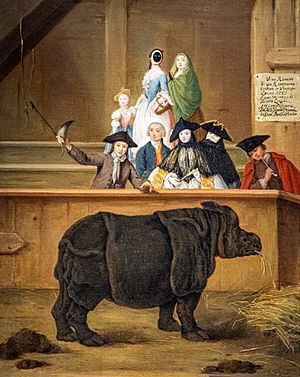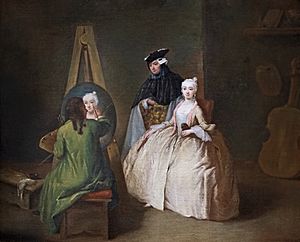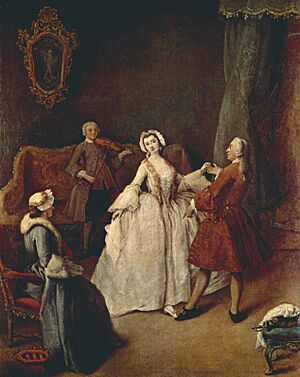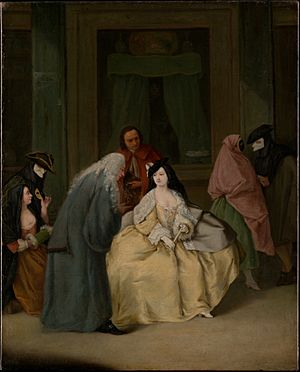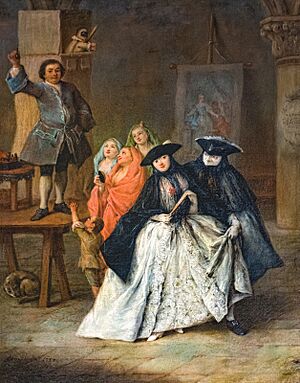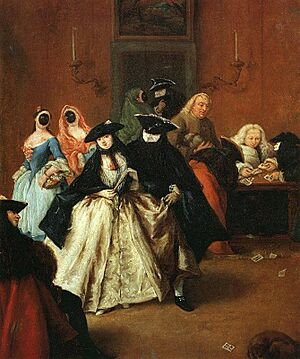Pietro Longhi facts for kids
Quick facts for kids
Pietro Longhi
|
|
|---|---|
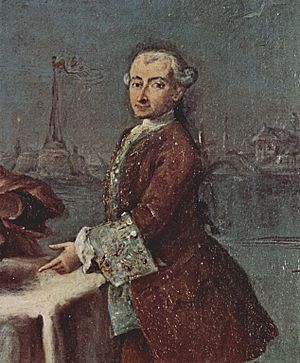
Self-portrait of Longhi
|
|
| Born | November 5, 1701 |
| Died | May 8, 1785 (aged 83) |
| Nationality | Italian |
Pietro Longhi (born 1701 or 1702, died 1785) was a famous Venetian painter. He was known for his unique paintings that showed everyday life in Venice. Instead of grand historical scenes, he focused on people, their activities, and the fun things they did.
About Pietro Longhi
Pietro Longhi was born in Venice. His father was a silversmith. Pietro started using the last name Longhi when he became a painter. He first learned from a painter named Antonio Balestra. Later, he studied with Giuseppe Crespi in Bologna, who was good at both religious and everyday-life paintings.
Pietro returned to Venice before 1732. He got married in 1732 to Caterina Maria Rizzi. They had eleven children, but only three lived to be adults.
At first, Pietro painted religious scenes and altarpieces for churches. One of his first big works was an altarpiece in 1732. In 1734, he painted amazing pictures on the walls and ceiling of a hall in Ca' Sagredo.
In the late 1730s, Pietro started focusing on the smaller, everyday scenes he became famous for. These paintings showed what life was like in Venice. They were very popular because they showed private moments and the lives of ordinary people, not just kings or gods.
Many of Pietro's paintings show Venetians having fun. For example, one famous painting shows a crowd of people looking at a real rhinoceros. This rhino, named Clara, was brought to Europe in 1741 and was shown in Venice in 1751. There are two versions of this painting, almost the same, but one shows two men without their masks.
Other paintings show daily activities, like people gambling in special rooms called Ridotti. In many of his paintings, about half the people have no faces because they are wearing Venetian Carnival masks. Sometimes, the way people stand or act in his paintings makes it seem like Pietro was gently making fun of them. This "puppet-like" style was on purpose, as his earlier drawings show he could paint figures very realistically. Pietro also made many drawings, often just for fun, not always as studies for his paintings.
In the 1750s, Pietro was asked to paint seven canvases showing the seven Catholic sacraments. These paintings are now in the Pinacoteca Querini Stampalia museum, along with his hunting scenes.
From 1763, Pietro Longhi was the Director of the Academy of Drawing and Carving. Around this time, he started painting many portraits, and his son, Alessandro Longhi, often helped him. Pietro Longhi passed away on May 8, 1785, after a short illness.
His Art Legacy
Pietro Longhi was special because he painted everyday life. While other famous Venetian painters like Canaletto and Francesco Guardi showed the grand outdoor events of Venice, Longhi showed us what was happening inside the homes and private rooms. He moved away from painting big myths and historical events, choosing instead to show the small, personal moments of his time. This makes his art a unique window into 18th-century Venetian life.
Masks in His Paintings
Pietro Longhi often painted people wearing masks. These masks were a big part of the Venetian Carnival and allowed people to hide their identity while doing various things, from gambling to flirting.
For example, in his painting The Meeting of the Procuratore and His Wife, a woman is greeted by her husband. They are not wearing masks. But in the same painting, a seated woman takes off her mask to talk to a masked man. This might mean her mask (a "Moretta" mask) didn't have a mouth opening, so she had to remove it to speak. Or, it could mean she was interested enough in the masked man to show him her true face.
In The Charlatan (1757), a charlatan (a person who pretends to have special skills) stands on a table in the background, surrounded by women and a boy. In the front, a masked woman seems to be playing with her fan and secretly looking at a masked man who lifts part of her dress. This painting shows two sides of Venetian life: the public show of the charlatan and the private, hidden desires of the masked couple. The masks allowed people to hide their faces but sometimes showed their true feelings.
In The Ridotto in Venice (around 1750s), Longhi shows one of the main gambling halls in Venice. The room is full of people, some masked and some not. The painting focuses on a shy woman and a man who lifts her dress. Longhi shows the Ridotto as a place where important people, who wouldn't act this way in public without masks, would let go of their usual rules and follow their hidden desires.
Gallery
See also
 In Spanish: Pietro Longhi para niños
In Spanish: Pietro Longhi para niños


